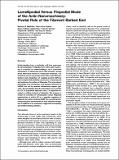| dc.contributor.author | Mejillano, Marisan R. | |
| dc.contributor.author | Kojima, Shin-ichiro | |
| dc.contributor.author | Applewhite, Derek Anthony | |
| dc.contributor.author | Svitkina, Tatyana M. | |
| dc.contributor.author | Borisy, Gary G. | |
| dc.contributor.author | Gertler, Frank | |
| dc.date.accessioned | 2014-01-06T17:14:23Z | |
| dc.date.available | 2014-01-06T17:14:23Z | |
| dc.date.issued | 2004-08 | |
| dc.date.submitted | 2004-06 | |
| dc.identifier.issn | 00928674 | |
| dc.identifier.issn | 1097-4172 | |
| dc.identifier.uri | http://hdl.handle.net/1721.1/83498 | |
| dc.description.abstract | Understanding how a particular cell type expresses the lamellipodial or filopodial form of the actin machinery is essential to understanding a cell's functional interactions. To determine how a cell “chooses” among these alternative modes of “molecular hardware,” we tested the role of key proteins that affect actin filament barbed ends. Depletion of capping protein (CP) by short hairpin RNA (shRNA) caused loss of lamellipodia and explosive formation of filopodia. The knockdown phenotype was rescued by a CP mutant refractory to shRNA, but not by another barbed-end capper, gelsolin, demonstrating that the phenotype was specific for CP. In Ena/VASP deficient cells, CP depletion resulted in ruffling instead of filopodia. We propose a model for selection of lamellipodial versus filopodial organization in which CP is a negative regulator of filopodia formation and Ena/VASP has recruiting/activating functions downstream of actin filament elongation in addition to its previously suggested anticapping and antibranching activities. | en_US |
| dc.description.sponsorship | National Institutes of Health (U.S.) (Grant GM58801) | en_US |
| dc.language.iso | en_US | |
| dc.publisher | Elsevier | en_US |
| dc.relation.isversionof | http://dx.doi.org/10.1016/j.cell.2004.07.019 | en_US |
| dc.rights | Article is made available in accordance with the publisher's policy and may be subject to US copyright law. Please refer to the publisher's site for terms of use. | en_US |
| dc.source | Elsevier Open Archive | en_US |
| dc.title | Lamellipodial Versus Filopodial Mode of the Actin Nanomachinery: Pivotal Role of the Filament Barbed End | en_US |
| dc.type | Article | en_US |
| dc.identifier.citation | Mejillano, Marisan R., Shin-ichiro Kojima, Derek Anthony Applewhite, Frank B. Gertler, Tatyana M. Svitkina, and Gary G. Borisy. “Lamellipodial Versus Filopodial Mode of the Actin Nanomachinery.” Cell 118, no. 3 (August 2004): 363-373. Copyright © 2004 Cell Press | en_US |
| dc.contributor.department | Massachusetts Institute of Technology. Department of Biology | en_US |
| dc.contributor.mitauthor | Gertler, Frank | en_US |
| dc.relation.journal | Cell | en_US |
| dc.eprint.version | Final published version | en_US |
| dc.type.uri | http://purl.org/eprint/type/JournalArticle | en_US |
| eprint.status | http://purl.org/eprint/status/PeerReviewed | en_US |
| dspace.orderedauthors | Mejillano, Marisan R.; Kojima, Shin-ichiro; Applewhite, Derek Anthony; Gertler, Frank B.; Svitkina, Tatyana M.; Borisy, Gary G. | en_US |
| dc.identifier.orcid | https://orcid.org/0000-0003-3214-4554 | |
| mit.license | PUBLISHER_POLICY | en_US |
| mit.metadata.status | Complete | |
